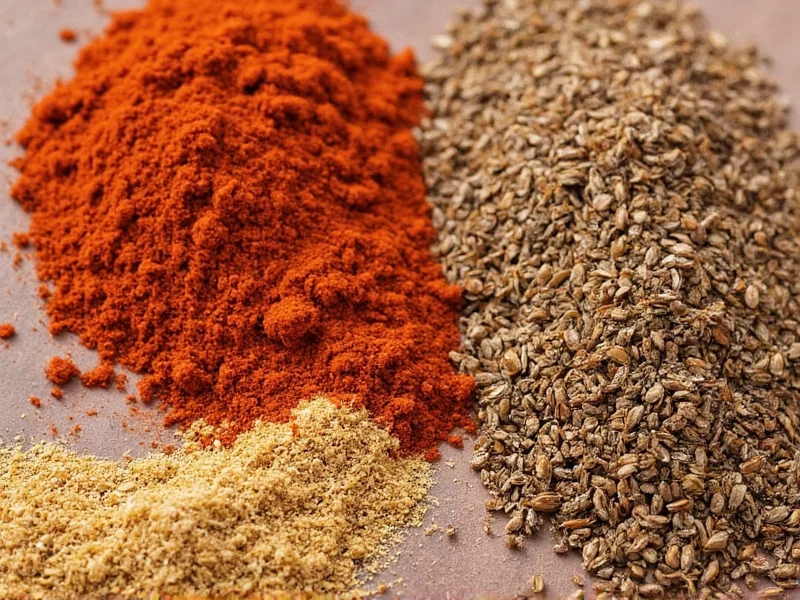Cajun spice blends deliver an unmistakable fiery kick that defines much of Louisiana cooking. Unlike many commercial spice mixes, authentic Cajun seasoning focuses on dry spices rather than liquid ingredients, creating a versatile rub that enhances proteins, vegetables, and grains. This foundational seasoning has evolved from the resourceful cooking traditions of French Acadians exiled to Louisiana in the 18th century, adapting to available ingredients while maintaining its characteristic heat and complexity.
The Essential Components of Cajun Spices
Understanding what makes Cajun spices unique requires examining their core ingredients. While recipes vary by family and region, certain elements consistently define this seasoning profile. The blend's heat comes primarily from cayenne pepper, while paprika provides color and subtle sweetness. Garlic and onion powders deliver aromatic depth, and black pepper contributes earthy warmth. Unlike Creole seasoning, traditional Cajun blends omit herbs like thyme and bay leaf that characterize New Orleans-style cooking.
| Core Ingredient | Typical Percentage | Flavor Contribution |
|---|---|---|
| Paprika | 30-40% | Earthy base, vibrant color, mild sweetness |
| Cayenne Pepper | 15-25% | Primary heat source, sharp intensity |
| Garlic Powder | 10-15% | Savory depth, aromatic complexity |
| Onion Powder | 10-15% | Sweet undertones, umami enhancement |
| Black Pepper | 5-10% | Earthy warmth, subtle pungency |
| Oregano | 3-5% | Herbal note, distinctive Cajun signature |
Historical Roots of Cajun Seasoning
The story of Cajun spices begins with the Acadian expulsion from Canada in the mid-1700s. French settlers who migrated to rural Louisiana developed this seasoning profile using available ingredients, creating what food historians call "country cooking." Unlike the more refined Creole cuisine of New Orleans, Cajun cooking emerged in the bayous and prairies, where cooks relied on dried spices that could be stored without refrigeration. This practical approach resulted in the dry spice blend we recognize today as authentic Cajun seasoning.
Cajun vs. Creole: Understanding the Difference
Many people confuse Cajun and Creole seasonings, but they represent distinct culinary traditions. The key difference between Cajun and Creole seasoning lies in their composition and origin. Cajun seasoning developed in rural Louisiana among Acadian settlers and features a dry spice blend focused on heat and earthiness. Creole seasoning, originating in New Orleans, typically includes additional herbs like thyme, bay leaf, and sometimes even tomato elements.
When considering what is Cajun spice blend made of versus Creole, remember that Cajun blends traditionally omit celery salt and thyme that characterize Creole seasoning. This distinction matters significantly when recreating authentic regional dishes. Understanding the difference between Cajun and Creole seasoning helps home cooks select the appropriate blend for specific recipes.
Practical Applications in Modern Cooking
Knowing how to use Cajun spices properly transforms ordinary dishes into extraordinary meals. The most effective technique for using Cajun seasoning involves applying it generously as a dry rub before cooking, allowing the spices to form a flavorful crust. This method works exceptionally well with proteins like chicken, shrimp, and sausage—the staples of traditional Cajun cuisine.
When incorporating Cajun spices into vegetable dishes, add the seasoning early in the cooking process to allow the flavors to meld. For soups and stews, introduce the spice blend after sautéing vegetables but before adding liquids to maximize flavor extraction. Remember that commercial blends vary in heat level, so adjust quantities accordingly when following recipes that specify "Cajun-spiced" ingredients.
Creating Your Own Authentic Blend
Mastering homemade Cajun spice blend gives you control over flavor intensity and freshness. The basic ratio for making Cajun seasoning starts with equal parts paprika and cayenne, then adds supporting spices. For a standard batch, combine 4 tablespoons paprika, 2 tablespoons cayenne pepper, 1 tablespoon each of garlic powder and onion powder, 2 teaspoons black pepper, and 1 teaspoon dried oregano.
Customization options for your Cajun spice blend include adjusting the cayenne content for more or less heat, adding a pinch of cumin for earthiness, or incorporating a small amount of white pepper for different heat notes. Properly stored in an airtight container away from light, homemade Cajun seasoning maintains peak flavor for 3-4 months—significantly longer than most store-bought versions.
Common Misconceptions About Cajun Seasoning
Several myths surround Cajun spices that deserve clarification. First, authentic Cajun seasoning contains no salt—this addition came later with commercial blends. Second, while often fiery, traditional Cajun cooking emphasizes balanced heat rather than overwhelming spiciness. Third, the notion that all Cajun food must be extremely hot represents a modern misconception; historical recipes focused more on flavor complexity than pure heat.
Understanding what Cajun spices really are helps cooks appreciate their nuanced role in Southern cooking. The best Cajun dishes showcase the seasoning blend as part of a harmonious flavor profile rather than as a standalone heat source. This knowledge proves essential when exploring how to use Cajun spices effectively in various culinary applications.











 浙公网安备
33010002000092号
浙公网安备
33010002000092号 浙B2-20120091-4
浙B2-20120091-4